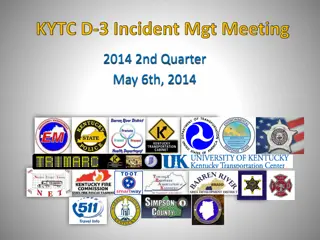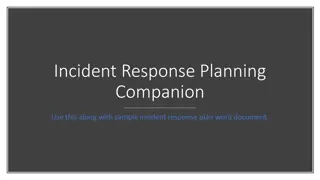Enhancing Incident Response Through Threat Intelligence
Explore the importance of threat intelligence in incident response, covering aspects such as understanding adversaries, assessing risks, evaluating threats, and leveraging strategic intelligence. Learn how organizations can benefit from a proactive approach to cybersecurity by utilizing threat intelligence to stay ahead of potential cyber threats.
Download Presentation

Please find below an Image/Link to download the presentation.
The content on the website is provided AS IS for your information and personal use only. It may not be sold, licensed, or shared on other websites without obtaining consent from the author.If you encounter any issues during the download, it is possible that the publisher has removed the file from their server.
You are allowed to download the files provided on this website for personal or commercial use, subject to the condition that they are used lawfully. All files are the property of their respective owners.
The content on the website is provided AS IS for your information and personal use only. It may not be sold, licensed, or shared on other websites without obtaining consent from the author.
E N D
Presentation Transcript
Indicators and Intelligence Incident Response
Threat Intelligence Information about adversaries Intelligence gathered about adversaries Threat landscape Need to understand how adversaries operate Broad -> Specific Broad to understand their techniques, useful for hunting + anomaly based searches Specific to understand exactly what they look like, useful for signatures Learn the tools, techniques, and infrastructure of adversaries Incident Response Threat landscapes vary between organizations Even by the same adversary 2
Understand your risk To begin to understand the threat, you need to characterize your org s risk Risk == Vulnerability + Impact + Threat Vulnerability What exposure does your system have? Any known weaknesses that could be leveraged? Impact What happens if you are compromised? Not something that can be changed by the organization, often just a factor of what what the organization is/has Incident Response Threat 3
Risk the threat Why would an adversary want to compromise the org? Does the adversary want to compromise the org? Do they gain anything? What do they gain? What capabilities does the adversary have? Does the adversary have the technical capability for successful compromise? Do identified vulnerabilities align with an adversary s capabilities? Incident Response 4
Threat Intelligence The idea is to have more risks in the known knowns category Ideally, as few unknown unknowns as possible Can come from many different sources News report about an attack on a flaw -to- Learning how an adversary is targeting a competing organization The UK s National Cyber Security Centre divides threat intelligence into four categories Strategic Operational Tactical Technical Incident Response 5
Strategic Intelligence High level Typically acquired at the board or high senior manager level Not technical information Typically about an attack s potential Financial impact Impact on business decisions Example: A report states a foreign government hacks into foreign companies with direct competitors in their own nation Your organization is identified as a competitor Incident Response 6
Operational Intelligence Information about a specific incoming attack Typically acquired by high level security staff Rarely available Typically only a government has access to such information No legal way for private companies to access this info on their own Rare cases the info may be available Public actors (hacktivists) Link cyber attacks to real world events Incident Response 7
Tactical Intelligence Information about how adversaries are conducting their attacks TTPs Tactics, Techniques, and Procedures Typically acquired by defenders and incident responders Example: Learning an adversary is using psexec to move laterally Block remote logins by admins and/or log and monitor this activity Typically obtained through: Talking with other defenders about what they re seeing Purchasing a threat feed of this information White papers Incident Response 8
Technical Intelligence Deeply technical data consumed through technical methods Example: Feed of malicious IP addresses Feed of malicious domain names Feed of malicious software hashes Often a short timeline attackers can change IP addresses Often feeds monitoring and alerting solutions Incident Response 9
Threat Intelligence Feeds Feed of indicators or artifacts from a third party Often focus on one indicator area IP addresses Domains Hashes Real-time Automatically updates with the latest available threat information Some free feeds, many paid feeds Six main data source types ideally cover as many as possible Open Source Customer telemetry Honeypots Scanning/crawling Malware processing Human intelligence Incident Response 10
Indicator of Compromise (IOC) Identifies characteristics of malware Host-based and network-based characteristics Can be used to identify the presence of malware on a compromised host IOCs are typically created by reversing malware Professional responders typically have large IOC lists collected from previous intrusions they have worked IOCs can save you time when analyzing multiple hosts Even if you only have one IOC for one piece of malware you found Incident Response Various standard languages to share indicators and threat intelligence 11
Standard sharing languages Standardization is important! Makes sharing easier Makes working with multiple data sources easier Different logs often refer to the same thing by different names Logged on Login success Accepted password Account Logon Sharing between different systems within the organization Incident Response Sharing with other organizations Need a common language to speak 12
CybOX Cybox.mitre.org Cyber Observable eXpression Standardized schema for describing observable events Event logging Malware characterization Intrusion detection Incident response Attack pattern characterization Standard structure and content Incident Response has been rolled into STIX the past few years 13
STIX Stix.mitre.org Structured Threat Information eXpression Community driven Standardized language to represent structured threat information Some examples: Malware Indicator for File Hash File Hash Reputation Incident Essentials Who, What, When Affected Asset list Command and Control IP List Incident Response 14
YARA Tool used to help identify and classify malware Pattern matching swiss knife for malware researchers (and everyone else) Create descriptions based on patterns Each rule has a set of strings and Boolean logic Any file containing one of the three strings is reported as a silent_banker match Incident Response 15
OpenIOC Openioc.org Open framework for threat intelligence sharing Originally designed for Mandiant s products Has since been standardized and open sourced IOCs are stored as XML IOC is made up of three major parts IOC Metadata Author of the IOC, Name of the IOC, description, etc. References Investigation name, case number, comments, etc Definition The content of the IOC itself artifacts, MD5 hash, registry path, etc. Incident Response 16
OpenIOC IOC Editor Allows users to work with indicators in XML format Manage the fields within the IOCs Edit the IOCs IOC Finder Search for IOCs on a single host Can be used to test new OICs Can be used to find malware on hosts IOC hit reporting in various formats, including HTML and text Reports for single or multiple hosts Incident Response 17
Lab - OpenIOC Incident Response 18























